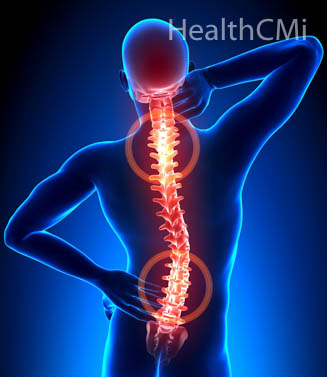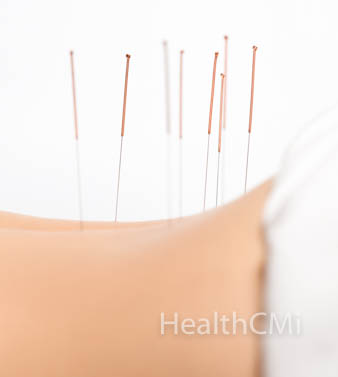Acupuncture speeds recovery from lumbar disc herniations. Researchers tested a protocol that increased the efficacy of electroacupuncture procedures for disc herniations by adding Chinese herbal medicine iontophoresis.  They discovered that the combined therapy of electroacupuncture plus herbal iontophoresis enhances clinical efficacy with a significant synergistic effect.
They discovered that the combined therapy of electroacupuncture plus herbal iontophoresis enhances clinical efficacy with a significant synergistic effect.
Patients had greater pain relief and lumbar functional improvements with the combination therapy. The total effective rate of electroacupuncture only was 87.5%. The combined therapy approach had a total effective rate of 95.0%. McGill and Japanese Orthopedic Association assessments using a Visual Analogue Scale (VAS) were used to calculate improvements.
A lumbar intervertebral disc herniation is a rupture of the annulus fibrosus that causes extrusion of the nucleus pulposus from the center of the disc. This often causes low back pain, weakness, or numbness that may radiate to the legs and feet. The researchers confirmed disc herniations for participants with diagnostic tests including CT scans, MRIs, and a positive Lasegue’s or Bragard’s sign. Patients were also evaluated with X-rays and an assessment of range of motion restrictions and pain levels. A total of 80 patients from the rehabilitation center at the Second Hospital Affiliated to Heilongjiang University of Traditional Chinese Medicine (TCM) participated in the study.
Acupuncture Points
The researchers used the following acupuncture points:
- Jiaji (Ex-B2, affected vertebral levels, bilateral)
- GB30 (Huantiao, affected side)
- Ashi
- GB34 (Yanglingquan, affected side for L4-5 herniations)
- BL40 (Weizhong, affected side for L5-S1 herniations)
Acupuncture Techniques
Disposable, single-use, sterile filiform needles of 0.30 mm diameter and a 40-75 mm length were used. Jiaji points were needled with 50 mm needles to a depth of approximately 40 mm. Needles were angled slightly towards the spine. Manual acupuncture was subsequently applied with an even reinforcing-reducing technique. The researchers note that the optimal response is if the patient reported a sensation radiating downwardly towards the buttocks and leg on the affected side. Electroacupuncture was then applied to the Jiaji points of the affected vertebral level. A sparse-dense setting was used with a 2 - 100 Hz frequency. Intensity was set to patient comfortability levels.
GB30 was needled using 75 mm needles and the remaining points were needled with 40 mm needles perpendicularly with the addition of the even reinforcing-reducing technique. The treatment duration was thirty minutes per acupuncture session.  Acupuncture treatments were applied once per day for 10 days followed by a three day break from treatments. Next, another course of ten acupuncture treatments over ten days was applied for a total of two courses of care.
Acupuncture treatments were applied once per day for 10 days followed by a three day break from treatments. Next, another course of ten acupuncture treatments over ten days was applied for a total of two courses of care.
Chinese Herbs
Iontophoresis is the administration of a substance through the skin by using a direct electric current. An LD-AE thermal treatment device was used to apply the current to the Chinese medicinal herbs. The herbs used in the iontophoresis procedure were:
- Qiang Huo (Rhizoma et Radix Notopterygii)
- Du Huo (Radix Angelicae Pubescentis)
- Xuan Shen (Radix Scrophulariae)
- Bi Xie (Rhizoma Dioscoreae Hypoglaucae)
- Sheng Di Huang (Radix Rehmanniae)
- Shu Di Huang (Radix Rehmanniae preparata)
- Dang Gui (Radix Angelicae Sinensis)
- Du Zhong (Cortex Eucommiae)
- Fang Feng (Radix Saposhnikoviae)
- Rou Gui (Cortex Cinnamomi)
- Gui Zhi (Ramulus Cinnamomi)
- Bai Zhi (Radix Angelicae Dahuricae)
- Ru Xiang (Olibanum)
- Mo Yao (Myrrha)
- Tian Ma (Rhizoma Gastrodiae)
A decoction was made of the herbal formula and cotton pads were soaked in it. The cotton was squeezed dry and placed over the electrodes. The positive electrodes were bilateral to the affected disc and the negative electrodes were placed distally on the side of the radiated pain or tender points on the buttocks. Sand packets were placed over the electrodes with cotton to compress and immobilize the cotton pads. The treatment was administered for thirty minutes per session.
Findings
The researchers reviewed current studies and commented on a few aspects of acupuncture therapy. Citing Zhao et al., they note that Jiaji electroacupuncture improves microcirculation to affected regions, speeds cell metabolism, transforms or reduces inflammatory substances, and reduces edema. Citing Yan et al., the researchers note that electroacupuncture “can alleviate pain by inhibiting the pathological reaction in the cerebral cortex through increasing opioid peptide release of periphery inflammatory tissues.”
Citing several studies (Yang et al., Yuan et al., Li et al.), the researchers note that electroacupuncture “at contralateral Jiaji (EX-B2) points can help to eliminate aseptic inflammation in intervertebral space through the current impulse, alleviate inflammatory irritation, and relieve compression to the nerve root.” Citing Chen et al., they add that electroacupuncture accelerates tissue metabolism, nurtures tissues, and reduces edema by stimulating rhythmic muscle contractions. Citing Cai et al., the researchers note that iontophoresis of Chinese herbal medicine increases blood circulation, relaxes muscles, and increases the efficacy of electrotherapy.
Evaluation
The researchers note that “EA (electroacupuncture) at lumbar Jiaji (EX-B2) points combined with iontophoresis of Chinese medicine can obtain better analgesic effect than EA alone. In addition, the effect tends to increase with time.” They add that the combined therapeutic approach speeds recovery, improves lumbar functions, and improves the pain relief therapeutic efficacy.
References:
Zhang, Jin-peng, Qiang Tang, and Lu-wen Zhu. "Electroacupuncture combined with iontophoresis of Chinese medicine for lumbar intervertebral disc herniation." Journal of Acupuncture and Tuina Science 2, no. 13 (2015): 105-110.
Zhao JY. Electroacupuncture at lumbar Jiaji (EX-B 2) points for lumbar disc herniation. JCAM, 2008, 24(4): 10-11.
Yan HL, Tao RG, Cao J, An J. Electroacupuncture for lumbar disc herniation in 31 cases. JCAM, 2002, 18(5): 39-40.
Yang SB, Mei ZG, Cai SJ, Chen JH, Zhou C. Clinical observation on treatment of different connectors used in electroacupuncture at Jiaji (EX-B 2) points for treatment of relapsed lumbar disc herniation. Hubei Zhongyi Zazhi, 2011, 33(6): 14-16.
Yuan FG, Liu F. Electroacupuncture using electrodes connecting lumbar vertebrae for lumbar disc herniation in 96 cases. Hebei J TCM, 2003, 25(10): 767-768.
Li L, Yuan K, Zhang LH, Wang H. Randomized controlled observation on treating lumbar disc herniation by EA at Jiaji (EX-B 2) points. Zhonghua Zhongyiyao Xuekan, 2013, 31(3): 630-632.
Chen XH, Guo SF, Han JS. Selection of optimal analgesic stimulation using sparse-dense wave in electroacupuncture. Beijing Yike Daxue Xuebao, 1993, 25(5): 338.
Cai YL, Wang SS, Wang Y. Observation and TCM care on low-temperature radiofrequency ablation combine with iontophoresis of Chinese medicine for lumbar disc herniation. Neimenggu Zhongyiyao, 2014, (6): 93.


